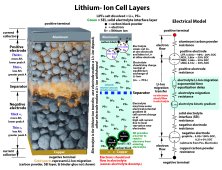12VoltInstalls
life passes by too quickly to not live in freedom
This is about high C-rate charging of manufactured LFP batteries.
Contents:
2:
I have two 140Ah 12V btrpower batteries to be series 12V and likely to order a third. 125A Class T fuses on each pos(+), 2ga series cables, 2/0 to busbar. Btrpower website, “…battery is equipped with 100A BMS (Battery Management System) to protect it from overcharge, over-discharge, over-current, and short circuit…”
Just received a new 200VOC Epever 6420AN. I think I have 2ga charging cables but might be 4ga- (I bought whatever the largest gage the Epever specs indicated would fit in the terminal fittings.)
Will plumb six new-old-stock 315W RecSolar panels 3S2P to it. Panels are 45.5VOC, nominal 36.8V, short circuit 9.09A, nominal power 8.62A.
Have a 4215AN and want to connect existing 100W panels 4S2P to same batteries. 6ga cables to battery busbar.
This will provide an expected 90- 100A of charging to the battery bank, or .5C for 2S, .33 for 3S
2000W QZRELB/Reliable psw inverter fed with 2/0 cables
3a:
Is my assumption correct the .5C will not affect the overall lifespan in any significant manner?
3b:
Am I correct that the Epever 6420AN won’t care that I feed it with 1890W nominal?
3c:
Should I set the 6420AN below the 4215AN’s charging cutoff by .1V or ___V?
3d:
I am typically opposed to using the ‘load’ terminals on an SCC. However, I would like to use the 4215AN’s load terminals to take advantage of its native kWh record keeping. My 12V circuit rarely sees 15A. Max load would be winter with the furnace fan; summer load will not have furnace load.
Q? Am I being overly or excessively OCD/hesitant to use the 4215AN load terminals?
The DC fusebox is rated at 100A but I used 8ga cable and fused the feed with a 30A ATC fuse (might be 20A) and it’s never blown.
While I believe all the above is acceptable use, input from individuals with more in-use experience and knowledge will be appreciated. Thank you
Contents:
- I’m studying up before I do something stupid because I know enough to know what I don’t know; I snippet-quote from other threads
- I comment on the context
- I ask a few questions
@Substrate said:LFP while discharging has no clue about where the juice is going, it does not care. When charging, it can take a low amp charge to full 1C or better (depending on your cells type).
c rate will be the maximum that one bms can handle
These threads are all over the place. While I learned some things I still thought I’d confirm my assumptions.posted one scientific paper that specifically says that DoD is a factor, but is much less significant than calendar time and temperature. He then posts a different scientific paper which doesn't even support his assertion.
2:
I have two 140Ah 12V btrpower batteries to be series 12V and likely to order a third. 125A Class T fuses on each pos(+), 2ga series cables, 2/0 to busbar. Btrpower website, “…battery is equipped with 100A BMS (Battery Management System) to protect it from overcharge, over-discharge, over-current, and short circuit…”
Just received a new 200VOC Epever 6420AN. I think I have 2ga charging cables but might be 4ga- (I bought whatever the largest gage the Epever specs indicated would fit in the terminal fittings.)
Will plumb six new-old-stock 315W RecSolar panels 3S2P to it. Panels are 45.5VOC, nominal 36.8V, short circuit 9.09A, nominal power 8.62A.
Have a 4215AN and want to connect existing 100W panels 4S2P to same batteries. 6ga cables to battery busbar.
This will provide an expected 90- 100A of charging to the battery bank, or .5C for 2S, .33 for 3S
2000W QZRELB/Reliable psw inverter fed with 2/0 cables
3a:
Is my assumption correct the .5C will not affect the overall lifespan in any significant manner?
3b:
Am I correct that the Epever 6420AN won’t care that I feed it with 1890W nominal?
3c:
Should I set the 6420AN below the 4215AN’s charging cutoff by .1V or ___V?
3d:
I am typically opposed to using the ‘load’ terminals on an SCC. However, I would like to use the 4215AN’s load terminals to take advantage of its native kWh record keeping. My 12V circuit rarely sees 15A. Max load would be winter with the furnace fan; summer load will not have furnace load.
Cell signal booster 6W
Water pump ~75W
Phone charger 10W
Range hood fan 70W
Lights (maxed out) ~115W (never happens)
VHF charger 22W
total max load -300W / 19A
Realistically I rarely exceed 12A and 19A may not have ever occurred.Q? Am I being overly or excessively OCD/hesitant to use the 4215AN load terminals?
The DC fusebox is rated at 100A but I used 8ga cable and fused the feed with a 30A ATC fuse (might be 20A) and it’s never blown.
While I believe all the above is acceptable use, input from individuals with more in-use experience and knowledge will be appreciated. Thank you




